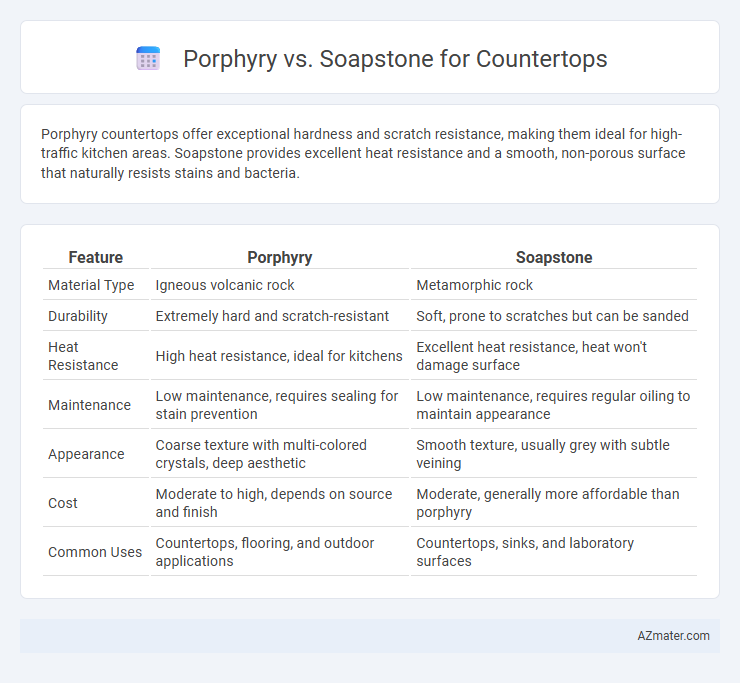Porphyry countertops offer exceptional hardness and scratch resistance, making them ideal for high-traffic kitchen areas. Soapstone provides excellent heat resistance and a smooth, non-porous surface that naturally resists stains and bacteria.
Table of Comparison
| Feature | Porphyry | Soapstone |
|---|---|---|
| Material Type | Igneous volcanic rock | Metamorphic rock |
| Durability | Extremely hard and scratch-resistant | Soft, prone to scratches but can be sanded |
| Heat Resistance | High heat resistance, ideal for kitchens | Excellent heat resistance, heat won't damage surface |
| Maintenance | Low maintenance, requires sealing for stain prevention | Low maintenance, requires regular oiling to maintain appearance |
| Appearance | Coarse texture with multi-colored crystals, deep aesthetic | Smooth texture, usually grey with subtle veining |
| Cost | Moderate to high, depends on source and finish | Moderate, generally more affordable than porphyry |
| Common Uses | Countertops, flooring, and outdoor applications | Countertops, sinks, and laboratory surfaces |
Introduction to Porphyry and Soapstone Countertops
Porphyry countertops are composed of igneous rock characterized by large, well-formed crystals embedded in a finer-grained matrix, offering exceptional durability and a distinctive, vibrant appearance ideal for high-traffic kitchen environments. Soapstone countertops, made primarily of talc, provide a smooth, matte surface known for its heat resistance and natural anti-bacterial properties, making them a popular choice for eco-friendly and low-maintenance kitchen designs. Both materials offer unique aesthetic and functional benefits, with porphyry excelling in hardness and longevity, while soapstone is prized for its softness and ease of repair.
Geological Origins and Composition
Porphyry countertops originate from igneous rock formed through slow cooling of magma, characterized by large, well-formed crystals embedded in a fine-grained matrix, mainly composed of feldspar and quartz. Soapstone is a metamorphic rock primarily composed of talc and magnesium-rich minerals, giving it a soft, soapy texture and excellent heat resistance. Porphyry offers exceptional hardness and durability due to its crystalline structure, while soapstone provides superior resistance to chemicals and stains because of its dense, non-porous composition.
Aesthetic Differences: Colors and Textures
Porphyry countertops exhibit a unique, coarse-grained texture characterized by large, multi-colored mineral crystals embedded in a fine-grained matrix, offering rich earth tones like deep reds, browns, and greens that create a dramatic, natural aesthetic. Soapstone features a smooth, velvety texture with a matte finish, typically presenting in soft shades of gray, black, and green, which lends a subtle, elegant, and timeless look to kitchen surfaces. The contrasting color palettes and surface finishes make porphyry ideal for bold, rustic designs, while soapstone suits minimalist and classic interiors seeking understated beauty.
Durability and Hardness Comparison
Porphyry countertops exhibit exceptional durability due to their dense, igneous rock composition, making them highly resistant to scratches, chips, and heat. Soapstone, while softer, offers moderate hardness with excellent resistance to staining and chemicals, though it is more prone to dents and surface wear over time. Porphyry's superior hardness rating on the Mohs scale (around 6-7) surpasses soapstone's lower range (1-2.5), ensuring long-lasting performance in high-traffic kitchen environments.
Maintenance and Care Requirements
Porphyry countertops require minimal maintenance due to their natural hardness and resistance to scratches and stains, needing only periodic sealing to maintain their durability and appearance. Soapstone countertops demand more frequent sealing and oiling to prevent surface wear and staining, but they resist heat and acidic substances effectively. Both materials benefit from gentle cleaning with pH-neutral products, though soapstone's softer nature necessitates careful handling to avoid dents and scratches.
Heat and Stain Resistance
Porphyry countertops exhibit exceptional heat resistance, maintaining integrity under high temperatures, making them ideal for kitchen environments where hot pots and pans are common. Soapstone offers superior stain resistance due to its non-porous nature and natural oils, which repel liquids and prevent discoloration over time. Both materials provide durable surfaces, but porphyry excels in heat tolerance while soapstone leads in resisting stains.
Cost: Installation and Long-Term Value
Porphyry countertops generally have a higher installation cost due to their dense, hard nature, which requires specialized tools and labor compared to the softer, more easily shaped soapstone. Soapstone tends to be more affordable upfront and offers excellent long-term value by resisting stains and heat without extensive maintenance, reducing repair costs over time. Porphyry's durability and unique aesthetic can increase a home's value, potentially offsetting the initial expense despite its higher installation price.
Environmental Impact and Sustainability
Porphyry countertops offer exceptional durability and longevity, reducing the need for frequent replacement and minimizing resource consumption over time. Soapstone is a natural, non-toxic material that is easily recycled and has minimal environmental impact during quarrying and processing. Both materials are sustainable choices, but soapstone's lower energy extraction and processing requirements make it slightly more eco-friendly.
Best Applications and Design Styles
Porphyry countertops offer exceptional durability and resistance to wear, making them ideal for high-traffic kitchens and commercial spaces, while soapstone is prized for its heat resistance and smooth, matte finish, suitable for rustic or farmhouse-style interiors. Porphyry's deep, rich tones and polished appearance complement modern and contemporary design schemes, whereas soapstone's natural veining and ability to develop a patina over time enhance traditional and vintage aesthetics. Both materials provide unique tactile experiences, with porphyry excelling in sleek, urban settings and soapstone favored in cozy, warm environments.
Choosing Between Porphyry and Soapstone Countertops
Porphyry countertops offer exceptional durability and resistance to scratches and heat, making them ideal for high-traffic kitchen areas, while soapstone provides a softer, heat-resistant surface that develops a unique patina over time. Porphyry's dense, coarse-grained texture ensures long-lasting performance but requires sealing to prevent stains, whereas soapstone is naturally non-porous and low-maintenance. Choosing between porphyry and soapstone countertops depends on whether you prioritize toughness and a polished aesthetic or prefer a softer, more rustic surface with minimal upkeep.

Infographic: Porphyry vs Soapstone for Countertop
 azmater.com
azmater.com